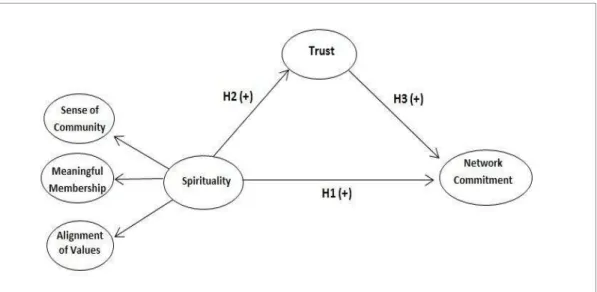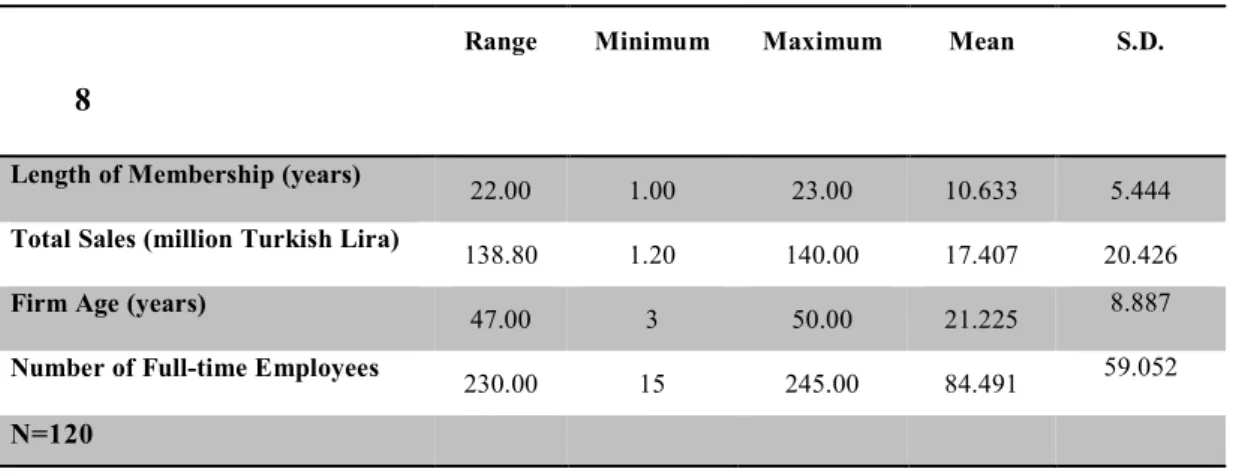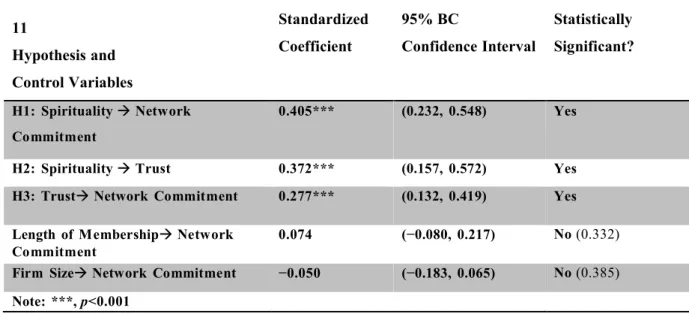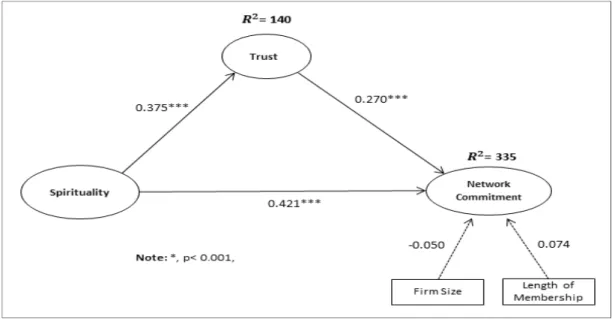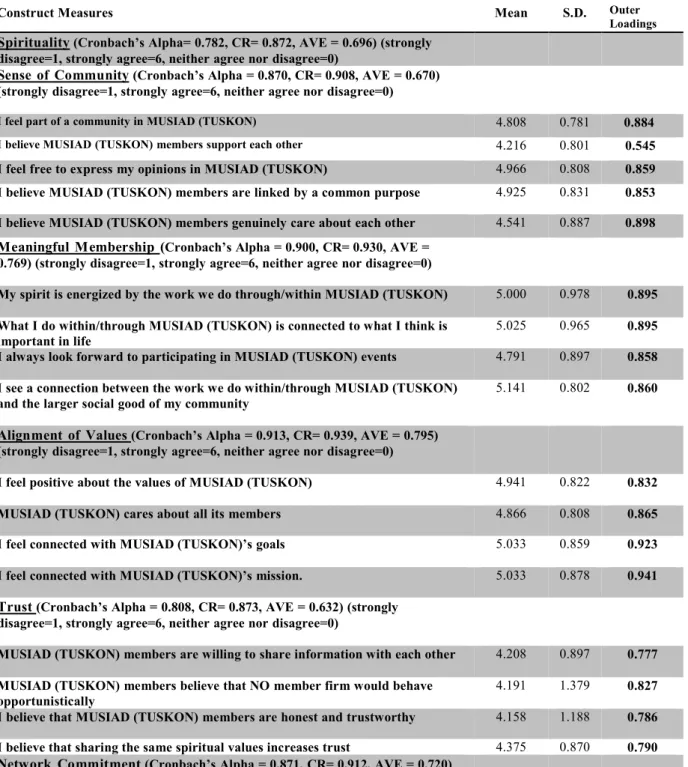The success of the Anatolian Tigers is mainly associated with their effective networking mechanisms (Baki Adaş, 2009; Buğra, 2002; Hosgör, 2011). Reflecting the narrow utilitarian perspectives that dominate the literature on network commitment, it has been strongly suggested that “we still know very little about the specific antecedent conditions that give rise to commitment in networks” (Clarke, 2006, p.1185).
Ring and Van De Ven (1994) pointed out that an assessment of the economic efficiency of past transactions determines the actors' decision to remain in an interorganizational relationship or not. In order to deepen our knowledge of the antecedents of network commitment, this study introduces spirituality into the relationship commitment research context and examines the extent to which it influences network commitment.
Spirituality
For example, Milliman et al. 2003, p. 428), in one of the first empirical studies to test the relationship between workplace spirituality and organizational commitment, measured the spirituality in the workplace construct through only three dimensions: 'meaningful work', 'sense of community' and 'alignment with the organization's values. ', imported from Ashmos and Duchon's study, this study also measures spirituality at the network level using three sub-dimensions: meaningful work (membership), sense of community, and value alignment. People are more likely to value a workplace in which they feel part of a community or connected to others there (Pfeffer, 2003).
Trust
These three dimensions for measuring workplace spirituality have been used and confirmed in various studies for different research contexts (Ashmos & Duchon, 2000; Duchon & Plowman, 2005; Milliman et al., 2003; Pawar, 2009).
3 Conceptual model and hypothesis development
Spirituality and network commitment
He suggests that a climate for spirituality among network members can create a set of shared perceptions through which more effective network mechanism and greater commitment can be achieved. This refers to sacred things that are not ordinary and deserve more respect and worship (Pargament & Mahoney, 2005). The relationship between spirituality and the conception of the sacred was identified by Hill et al. 2000, p. 64) who says that "ideologies, activities and lifestyles are not spiritual.
Individuals are more likely to protect, preserve and invest more in what they consider sacred, as such objects evoke feelings of devotion, reverence, respect and congruence in individuals. It has also been highlighted that people in communities can be connected to each other through their common understanding of the sacred (Pargament, 2008).
Spirituality and trust among network members
Applying this to our research context, we argue that, since Anatolian Tigers perceive their membership and networks as sacred, they are more likely to commit to their networks. H1: The greater the experience of spirituality among network members, the greater their commitment to networks. While the relationship between spirituality and trust has previously been investigated in the context of the workplace and within organizational boundaries, looking at trust between employees or between employer and employee, say, we focus on trust at the network level.
In our research context, common spiritual values are highlighted as one of the main drivers of trust among Anatolian Tigers. H2: The greater the experience of spirituality among the network members, the more trust exists among them.
Trust and network commitment
The greater the experience of spirituality among the network members, the more trust exists among them. In their seminal work, Morgan and Hunt (1994) also revealed that trust is a significant antecedent of network commitment. Otherwise, 'distrust breeds mistrust' and actors seek short-term exchange benefits rather than long-term network commitment (McDonald, 1981, p. 834).
In the context of spirituality, we suggest that through spirituality, network members can develop trust in each other, which creates a benevolent climate among the actors (Giacalone & Jurkiewicz, 2003). The relevant literature has considered benevolence, which deals with genuine concern and care for the partner rather than following a purely egocentric profit motive, as a key underlying pillar of trust (Ganesan & Hess, 1997; Rempel, Holmes, & . Zanna , 1985). .
4 Research methods
Exploratory interviews, sampling and data collection
H3: The greater trust that is built through the spiritual climate among the network members, the greater their commitment to the networks. To do this, initial contact was made with the branch offices of the business associations in the four randomly selected locations (Kayseri, Konya, Bursa and Inegol) and they were asked to introduce the researcher to the possible respondents (randomly selected) who met the given criteria . Questionnaires were implemented face to face with owners/top managers of 120 SMEs belonging to MUSIAD or TUSKON.
The survey data were collected over three months (mid-April and mid-May 2014 and July-September 2014). Since the data was collected in Turkey, an EU candidate country, we consider it as "European" data.
Measurement
This enabled us to theorize about and also evaluate the influence of spirituality (higher-order construct), rather than the influence of its three dimensions, on trust and network commitment (Polites et al., 2012). We initially defined the relationships between the spirituality construct and its dimensions and then developed conceptual arguments between spirituality, trust and network commitment (Wong et al., 2008). This means that the first-order dimensions of spirituality (sense of community, alignment of values and meaningful membership) differ (Polites et al., 2012).
Trust is conceptualized as “a willingness to rely on an exchange partner in whom one has confidence” (Moorman et al., 1993a, p.82). The construct of network involvement was measured using four items on a seven-point Likert scale adapted from the studies of Sherer (2003) and Morgan and Hunt (1994).
Control variables
5 Results
Measurement model results
All the above results guarantee the reliability of the measurement in our measurement model. A square root of AVE higher than the cross-loading value confirms the discriminant validity of the constructs (Fornell & Larcker, 1981; Hair, Black, Babin, & . Anderson, 2010). A more recent alternative approach to the discriminant validity assessment is to check the HTMT ratio of the correlations, developed by Henseler, Ringle, and Sarstedt (2014b).
We also applied the bootstrapping procedure to test the distribution of the HTMT statistic (Hair et al., 2017). Our findings show that none of the confidence intervals include the value 1, which confirms that the constructs are empirically distinct and indicates that the constructs have discriminant validity (Hair et al., 2017).
Structural model results
The results presented in Table 2 confirm the discriminant validity of our constructs (Fornell & Larcker, 1981). The HTMT results presented in Table 2 are all below the conservative threshold of 0.85, again warranting discriminant validity (Henseler et al., 2014b). To check whether the HTMT values were significantly different from 1, we calculated bootstrap confidence intervals from the 5000 bootstrap samples (Hair et al., 2017).
We perform a blindfold test to assess the predictive relevance of the path model (Hair et al., 2017). We also calculated the effect size, which reflects the contribution of the exogenous construct to the value of the endogenous latent variable (Hair et al., 2017).
Hypothesis testing
We controlled for the effects of length of membership and firm size on network commitment. We found a significant indirect effect of the relationship of spirituality to network commitment (0.101), as the 95% confidence interval does not include zero. Both the direct and indirect effects of spirituality to network commitment are significant (Table 5), indicating that trust partially mediates the relationship between them (Hair et al., 2017).
Therefore, the results reveal that trust represents a complementary partial mediation in the path from spirituality to network commitment. This complementary mediation suggests that trust explains the relationship between spirituality and network commitment (Nitzl et al., 2016).
6 Discussion and conclusion 6.1 Theoretical contribution
Practical implications
Based on our findings at the network level, we can also confirm that spirituality should be practiced by organizations while they are engaging with other economic and social actors through networks. Since more effective network mechanisms are more likely to create better network outcomes for organizations, they should encourage preconditions, such as spirituality, to foster trust, network engagement, and in turn effective network outcomes. Moreover, as previously shown, the vibrant activities involved in the Anatolian Tigers through their effective network mechanisms have fostered economic development and modernization in second- and third-tier cities across Turkey.
Relating that result to our findings, we can argue that spirituality-driven networks among Anatolian Tigers create an effective mechanism through which collective development can be achieved. Therefore, policy makers can exploit this potential in any country whose population mainly shares a common Islamic identity (or the common Christian identity of European countries), to foster effective networking mechanisms between businessmen and other economic actors and social.
Limitations and future research
Additionally, a comparative study could be conducted to show the differences between spiritual networks and other types of marketing networks. Future research should focus specifically on spiritually oriented networks and explore the distinctive characteristics of networks and the outcomes of these networks and their impact on firm performance. While traditional views of PLS considered PLS path models as recursive (i.e., no feedback loops), current contemporary views argue that they may contain feedback loops (Henseler et al., 2016).
If path models are non-recursive, instrumental variable techniques such as two-stage least squares should be used, which also provide multiple criteria for model evaluation (Henseler et al., 2016, p. 5). We therefore suggest that further research assess feedback loops in path models and use appropriate instrumental variable techniques.
7 Appendix
We are very committed to our MUSIAD (TUSKON) networks. We make the maximum effort to maintain our relationship with MUSIAD.

14 References
An assessment of the use of partial least squares structural equation modeling in marketing research. Network network studies: An analysis of conceptual configurations in the study of interorganizational relationships. Individual spirituality, workplace spirituality, and work attitudes: An empirical test of direct and interaction effects.
Determinants of trust in supplier relationships: Evidence from the automotive industry in Japan and the United States. The strategic role of relational bonding in interorganizational collaborations: An empirical study of the global construction industry.
